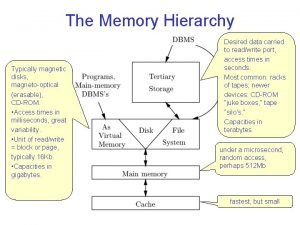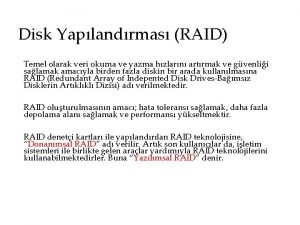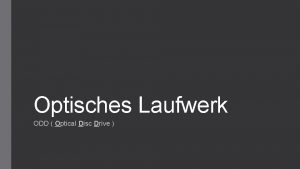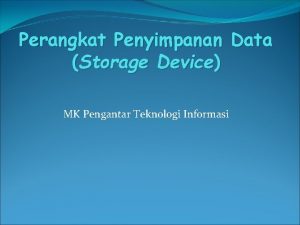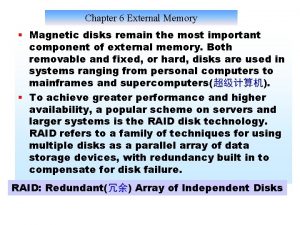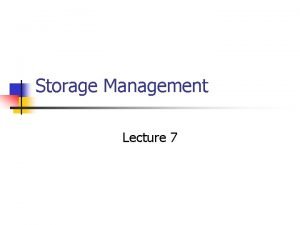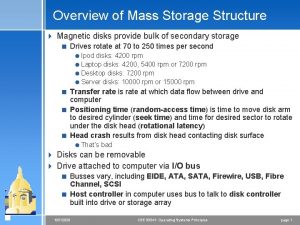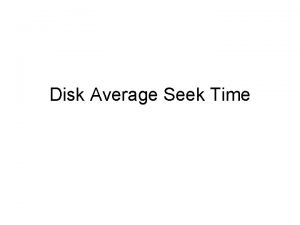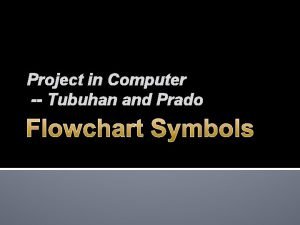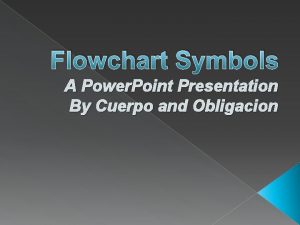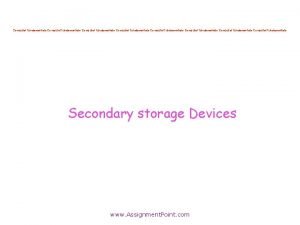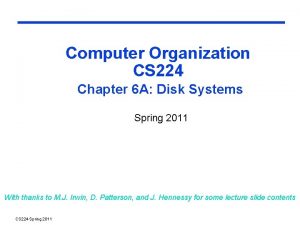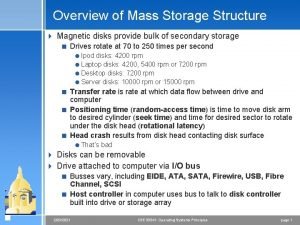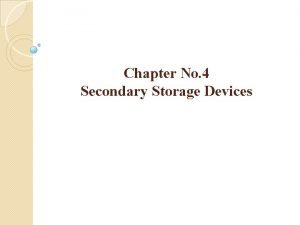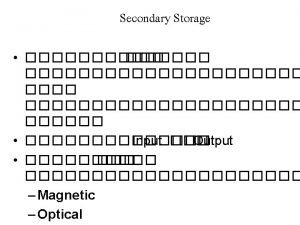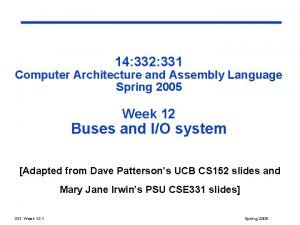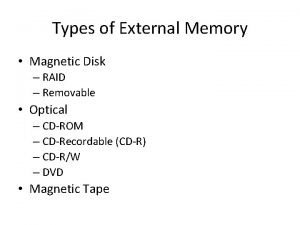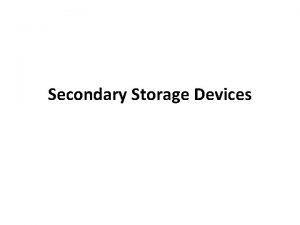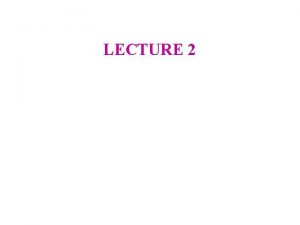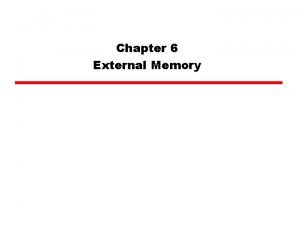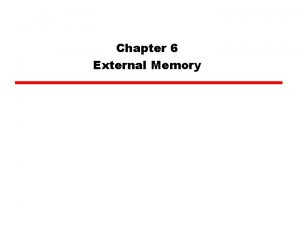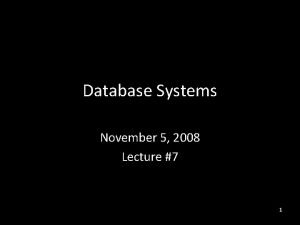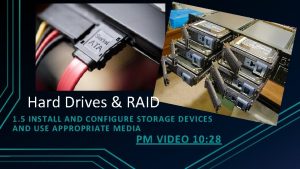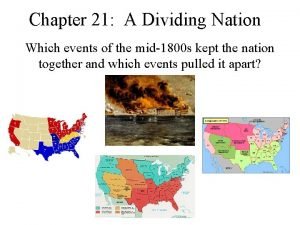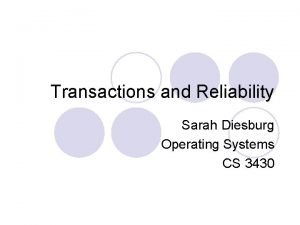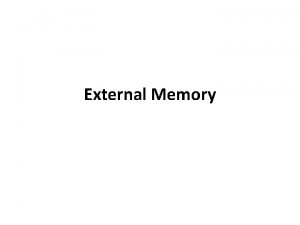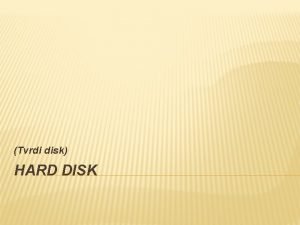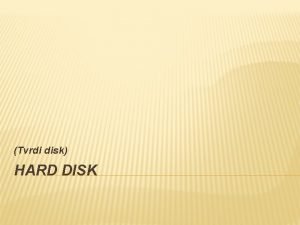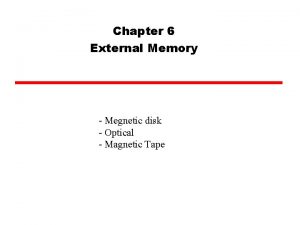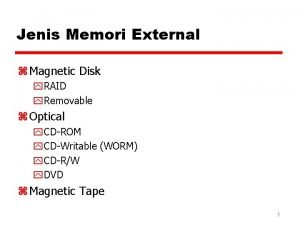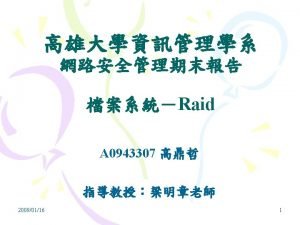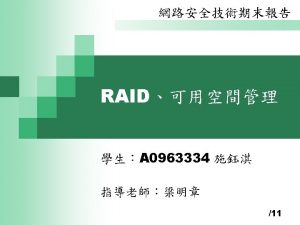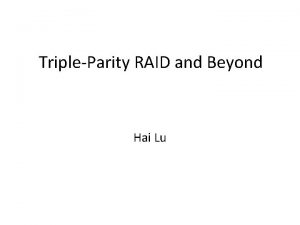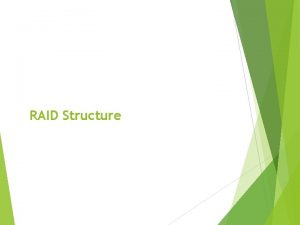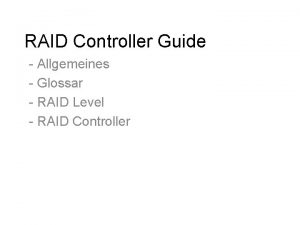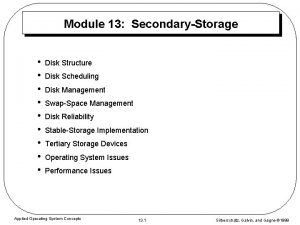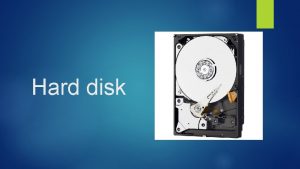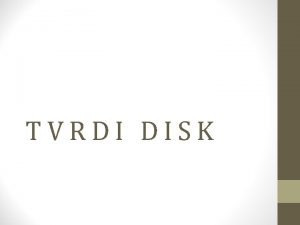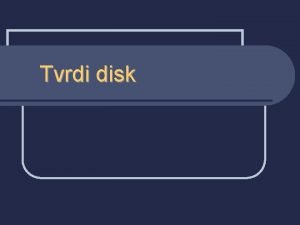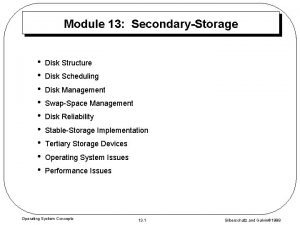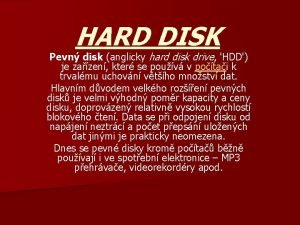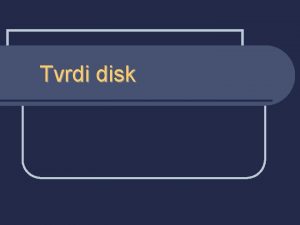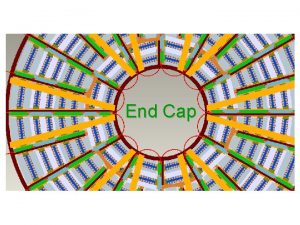CH 06 External Memory Magnetic Disk RAID Optical












































- Slides: 44

CH 06 External Memory • • Magnetic Disk RAID Optical Memory Magnetic Tape TECH Computer Science CH 05

Types of External Memory • Magnetic Disk Q RAID Q Removable • Optical Q CD-ROM Q CD-Writable (WORM) Q CD-R/W Q DVD • Magnetic Tape

Magnetic Disk • Metal or plastic disk coated with magnetizable material (iron oxide…rust) • Range of packaging Q Floppy Q Winchester hard disk Q Removable hard disk

Data Organization and Formatting • Concentric rings or tracks Q Gaps between tracks Q Reduce gap to increase capacity Q Same number of bits per track (variable packing density) Q Constant angular velocity • Tracks divided into sectors • Minimum block size is one sector • May have more than one sector per block

Disk Data Layout

Fixed/Movable Head Disk • Fixed head Q One read write head per track Q Heads mounted on fixed ridged arm • Movable head Q One read write head per side Q Mounted on a movable arm

Fixed and Movable Heads

Removable or Not // • Removable disk Q Can be removed from drive and replaced with another disk Q Provides unlimited storage capacity Q Easy data transfer between systems • Nonremovable disk Q Permanently mounted in the drive

Floppy Disk • 8”, 5. 25”, 3. 5” • Small capacity Q Up to 1. 44 Mbyte (2. 88 M never popular) • Slow (disk rotate at 300 and 600 rpm, average delay 100/2 and 200/2 ms. ) • Universal • Cheap

Winchester Hard Disk (1) • • Developed by IBM in Winchester (USA) Sealed unit One or more platters (disks) Heads fly on boundary layer of air as disk spins (crash into disk!) • Very small head to disk gap • Getting more robust

Winchester Hard Disk (2) • Universal • Cheap • Fastest external storage (typically rotate 3600 rpm, newer faster, average rotational delay 8. 3 ms. ) • Getting larger all the time Q Multiple Gigabyte now usual

Removable Hard Disk • ZIP Q Cheap Q Very common Q Only 100 M • JAZ Q Not cheap Q 1 G • L-120 (a: drive) Q Also reads 3. 5” floppy Q Becoming more popular?

Finding Sectors • Must be able to identify start of track and sector • Format disk Q Additional information not available to user Q Marks tracks and sectors

ST 506 format (old!) Gap 1 Id Sync Byte Gap 2 Data Gap 3 Gap 1 Id Track Head Sector CRC • Foreground reading Q Find others Gap 2 Data Gap 3 Sync Byte Data CRC

Characteristics • • • Fixed (rare) or movable head Removable or fixed Single or double (usually) sided Single or multiple platter Head mechanism Q Contact (Floppy) Q Fixed gap Q Flying (Winchester)

Multiple Platter • • One head per side Heads are joined and aligned Aligned tracks on each platter form cylinders Data is striped by cylinder Q reduces head movement Q Increases speed (transfer rate)

Speed • Seek time Q Moving head to correct track • (Rotational) latency Q Waiting for data to rotate under head • Access time = Seek + Latency • Transfer rate T = (number of bytes to be transferred)/(rotation speed)/(number of bytes on a track) = b/(r. N) • total access time Ta = Ts + 1/(2 r) + b/(r. N)

Sequential organization vs. random access e. g. Q e. g. a hard disk has average seek time of 20 ms, a transfer rate of 1 M byte/s, and 512 byte sectors with 32 sectors per track. Need to read a file consisting 256 sectors for a total of 128 K bytes. What is the total time for the transfer? • Case 1: Sequential Organization (256 sectors on 8 tracks x 32 sectors/tracks) Q Average seek time = 20. 0 ms Q Rotational delay = 8. 3 ms Q Read 32 sections (one track) = 16. 7 ms Q total time to read first track = 45 ms Q Total time = 45 ms + 7*(8. 3 + 16. 7) ms = 0. 22 s

Time required for random access on highly fragmented organization • Case 2: random access rather than sequential access Q Average seek time = 20. 0 ms Q Rotational delay = 8. 3 ms Q Read 1 sector = 16. 7/32 = 0. 5 ms Q time to read one sector = 28. 8 ms Q Total time = 256 * 28. 8 ms = 7. 37 s • De-fragment you hard disk!

Optical Storage CD-ROM // • Originally for audio • 650 Mbytes giving over 70 minutes audio • Polycarbonate coated with highly reflective coat, usually aluminum • Data stored as pits • Read by reflecting laser • Constant packing density • Constant linear velocity

Constant Angular Velocity vs. Constant Linear Velocity

CD-ROM Drive Speeds • Audio is single speed Q Constant linear velocity Q 1. 2 ms-1 Q Track (spiral) is 5. 27 km long Q Gives 4391 seconds = 73. 2 minutes Q Date 176. 4 K bytes/s total capacity 774. 57 M Bytes • Other speeds are quoted as multiples • e. g. 24 x ~= 4 M Bytes/s (data transfer rate) • The quoted figure is the maximum the drive can achieve

FF 00 x 10 00 Min Sector Mode CD-ROM Format 12 byte Sync 4 byte Id Data 2048 byte 2352 byte • Mode 0=blank data field • Mode 1=2048 byte data+error correction • Mode 2=2336 byte data Layered ECC 288 byte

Random Access on CD-ROM • • • Difficult Move head to rough position Set correct speed Read address Adjust to required location (Yawn!)

CD-ROM for & against • • Large capacity (? ) Easy to mass produce Removable Robust • Expensive for small runs • Slow • Read only

Other Optical Storage • CD-Writable Q WORM Q Now affordable Q Compatible with CD-ROM drives • CD-RW Q Erasable Q Getting cheaper Q Mostly CD-ROM drive compatible

DVD - what’s in a name? • Digital Video Disk Q Used to indicate a player for movies f. Only plays video disks • Digital Versatile Disk Q Used to indicate a computer drive f. Will read computer disks and play video disks • Dogs Veritable Dinner • Officially - nothing!!!

DVD - technology • Multi-layer • Very high capacity (4. 7 G per layer) • dual-layer (single-sided ? ) hold 8. 5 Gbytes ~> 4 hr movie • Full length movie on single disk Q Using MPEG compression • Finally standardized (honest!) • Movies carry regional coding • Players only play correct region films

DVD - Writable • Loads of trouble with standards • First generation DVD drives may not read first generation DVD-W disks • First generation DVD drives may not read CD-RW disks • Wait for it to settle down before buying!

Foreground Reading • Check out optical disk storage options • Check out Mini Disk

Magnetic Tape • • Serial access Slow Very cheap Backup and archive

Digital Audio Tape (DAT) • Uses rotating head (like video) • High capacity on small tape Q 4 Gbyte uncompressed Q 8 Gbyte compressed • Backup of PC/network servers

RAID • • • Redundant Array of Independent Disks Redundant Array of Inexpensive Disks 6 levels in common use Not a hierarchy Set of physical disks viewed as single logical drive by O/S • Data distributed across physical drives • Can use redundant capacity to store parity information

RAID Levels 0, 1, 2

RAID Levels 3, 4

RAID Levels 5, 6

RAID 0 • • No redundancy Data striped across all disks Round Robin striping Increase speed Q Multiple data requests probably not on same disk Q Disks seek in parallel Q A set of data is likely to be striped across multiple disks

RAID 1 • • • Mirrored Disks Data is striped across disks 2 copies of each stripe on separate disks Read from either Write to both Recovery is simple Q Swap faulty disk & re-mirror Q No down time • Expensive

RAID 2 • Disks are synchronized • Very small stripes Q Often single byte/word • Error correction calculated across corresponding bits on disks • Multiple parity disks store Hamming code error correction in corresponding positions • Lots of redundancy Q Expensive Q Not used

RAID 3 • Similar to RAID 2 • Only one redundant disk, no matter how large the array • Simple parity bit for each set of corresponding bits • Data on failed drive can be reconstructed from surviving data and parity info • Very high transfer rates

RAID 4 • • • Each disk operates independently Good for high I/O request rate Large stripes Bit by bit parity calculated across stripes on each disk Parity stored on parity disk

RAID 5 • • • Like RAID 4 Parity striped across all disks Round robin allocation for parity stripe Avoids RAID 4 bottleneck at parity disk Commonly used in network servers

RAID 6 • Two different parity calculations are carried out and • stored in separate blocks on different disks. • Able to regenerate data even if two disks containing user data fail

 Magnetic disk in memory hierarchy
Magnetic disk in memory hierarchy Raid 5 nasıl yapılır
Raid 5 nasıl yapılır Internal memory and external memory
Internal memory and external memory Was ist odd
Was ist odd Perangkat penyimpanan disebut juga dengan
Perangkat penyimpanan disebut juga dengan Data organization and formatting of magnetic disk
Data organization and formatting of magnetic disk Types of storage management
Types of storage management Disadvantages of current transformer
Disadvantages of current transformer Magnetic disk structure
Magnetic disk structure Seek time in magnetic disk
Seek time in magnetic disk Flowchart magnetic disk
Flowchart magnetic disk Collate flowchart
Collate flowchart Assignment on storage devices
Assignment on storage devices Magnetic disk
Magnetic disk Structure of magnetic disk
Structure of magnetic disk Magnetic disk
Magnetic disk Floppy disk secondary storage
Floppy disk secondary storage Magnetic disk
Magnetic disk Types of magnetic disks
Types of magnetic disks Permeability unit
Permeability unit Magnetic moment and magnetic field relation
Magnetic moment and magnetic field relation F=i(lxb)
F=i(lxb) The coercive force in a ferromagnetic material is
The coercive force in a ferromagnetic material is Magnetic tape in secondary memory
Magnetic tape in secondary memory Magnetic bubble memory ppt
Magnetic bubble memory ppt External-external trips
External-external trips Types of external memory
Types of external memory External memory types
External memory types Shared memory vs distributed memory
Shared memory vs distributed memory Long term memory vs short term memory
Long term memory vs short term memory Virtual memory and cache memory
Virtual memory and cache memory Semantic knowledge
Semantic knowledge Primary memory and secondary memory
Primary memory and secondary memory Virtual memory in memory hierarchy consists of
Virtual memory in memory hierarchy consists of Implicit explicit memory
Implicit explicit memory Logical and physical address in os
Logical and physical address in os Eidetic memory vs iconic memory
Eidetic memory vs iconic memory Which memory is the actual working memory?
Which memory is the actual working memory? What century did the vikings exist
What century did the vikings exist Raid in dbms
Raid in dbms Raid duplexing
Raid duplexing Fugitive slave act passed two key details
Fugitive slave act passed two key details Practical byzantine fault tolerance
Practical byzantine fault tolerance Raid
Raid Sarah diesburg
Sarah diesburg
